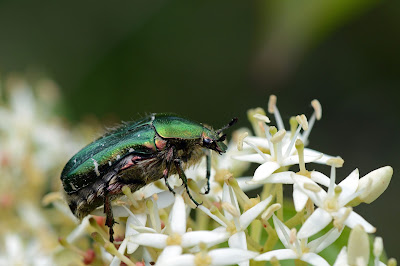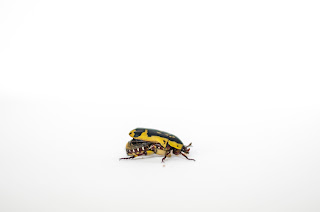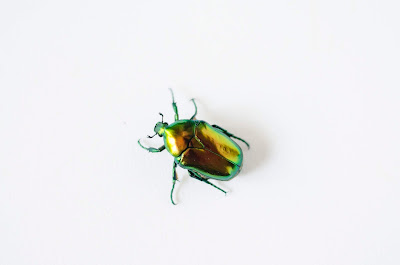Protaetia (Potosia) cretica in breeding
Recently I went to another entomologic fair in Mons, Belgium. This fair had a lot to offer, many interesting people to speak etc. In between the dried beetles, there were also some beetle breeders present. However, the most special species I found was wel hidden in between boxes of dried beetles and butterflies: larvae of Protaetia (potosia) cretica (Kraatz, 1880).
Potosia cretica is a matt-black beetle with slight punctuation in the elytrae. Depending on the light a slight green shade can be seen. The ventral side is somewhat more metallic with a smooth green or blue shade. The size of the beetle is about 17-25mm. As the name states, this beetle can be found on the Greek island of Crete, where the species is endemic. It occurs nowhere else in the world.
Below a picture of Potosia cretica in their natural habitat. All the photo credit goes to ,Francesco Vitali, an entomologist based in Luxembourg.
The seller had them just in oak leafs. When I got home I put them in a bigger tub. The original substrate and the larvae were put on the bottom of the tub, then I added a mixture of flakesoil and crushed kinshi blocks to fill the box up. I am keeping 6 L3 larvae in a 5 liter box. This way the larvae have a smaller chance of disrupting other larvae making their pupal cells. The larvae are kept at a gentle 20°C. I have no idea what the ideal temperature would be, as I have no information on where the larvae of this species are mostly found. Below a temperature chart of the island of Crete, showing an average high of 28°C and average low of 10°C. This ofcourse, doesn't completely reflect temperature below the ground, in hollow trees etc. were larvae might occur.
The first check-up of larvae was promising already. The larvae were getting nice and fat with a slightly creamy yellow colour, as it should be for late stage Protaetia grubs. I plan to leave them in their tub for 2-3 months to minimalise stress-levels or disturbance during cell construction. They have enough quality substrate to prepare for and enter pupation. I will update later on the breeding of this seldom seen species.
Regards from Belgium
Domien
Below a picture of Potosia cretica in their natural habitat. All the photo credit goes to ,Francesco Vitali, an entomologist based in Luxembourg.
 |
| Beetle on the left and the lowest are P. morio, on the right P. cretica |
The seller had them just in oak leafs. When I got home I put them in a bigger tub. The original substrate and the larvae were put on the bottom of the tub, then I added a mixture of flakesoil and crushed kinshi blocks to fill the box up. I am keeping 6 L3 larvae in a 5 liter box. This way the larvae have a smaller chance of disrupting other larvae making their pupal cells. The larvae are kept at a gentle 20°C. I have no idea what the ideal temperature would be, as I have no information on where the larvae of this species are mostly found. Below a temperature chart of the island of Crete, showing an average high of 28°C and average low of 10°C. This ofcourse, doesn't completely reflect temperature below the ground, in hollow trees etc. were larvae might occur.
The first check-up of larvae was promising already. The larvae were getting nice and fat with a slightly creamy yellow colour, as it should be for late stage Protaetia grubs. I plan to leave them in their tub for 2-3 months to minimalise stress-levels or disturbance during cell construction. They have enough quality substrate to prepare for and enter pupation. I will update later on the breeding of this seldom seen species.
Regards from Belgium
Domien





Comments